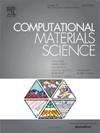Confidence-Aware Mean Teacher for semi-supervised metallographic image semantic segmentation
IF 3.1
3区 材料科学
Q2 MATERIALS SCIENCE, MULTIDISCIPLINARY
引用次数: 0
Abstract
Semantic segmentation of metallographic images using deep learning has become an emerging topic in materials science. However, existing methods generally rely on plenty of labeled images for supervised learning but pay insufficient attention to the problems of class imbalance and limited samples in datasets, which usually result in degraded model performance. Therefore, to accurately segment microstructures in metallographic images, we propose a new semi-supervised semantic segmentation model called Confidence-Aware Mean Teacher Network (CA-MT). By generating pseudo-labels, unlabeled images can also participate in training. According to the learning state of the model at different stages, the training process is divided into three phases: exploration, growth, and stabilization, and different strategies are applied to generate adaptive pseudo-labels, respectively. This can improve the quality of the training set and enable the model to learn more adequate semantic information for each class. Meanwhile, data augmentation is an effective way to improve the generalization ability of the model in a sample-limited situation. Based on this, we propose an adaptive threshold adjustment strategy (CCAT) depending on the class confidence to deal with the class imbalance problem and an adaptive CutMix augmentation method (CDAC) that utilizes the global confidence of unlabeled images as a guide to mitigate the disturbance caused by insufficient samples. Experiments show that CA-MT outperforms five state-of-the-art semi-supervised segmentation models under different partitioning protocols for two metallographic image datasets, MetalDAM and UHCS. The source code of the present work is available in https://github.com/Cccoral/CA-MT.

求助全文
约1分钟内获得全文
求助全文
来源期刊

Computational Materials Science
工程技术-材料科学:综合
CiteScore
6.50
自引率
6.10%
发文量
665
审稿时长
26 days
期刊介绍:
The goal of Computational Materials Science is to report on results that provide new or unique insights into, or significantly expand our understanding of, the properties of materials or phenomena associated with their design, synthesis, processing, characterization, and utilization. To be relevant to the journal, the results should be applied or applicable to specific material systems that are discussed within the submission.
 求助内容:
求助内容: 应助结果提醒方式:
应助结果提醒方式:


